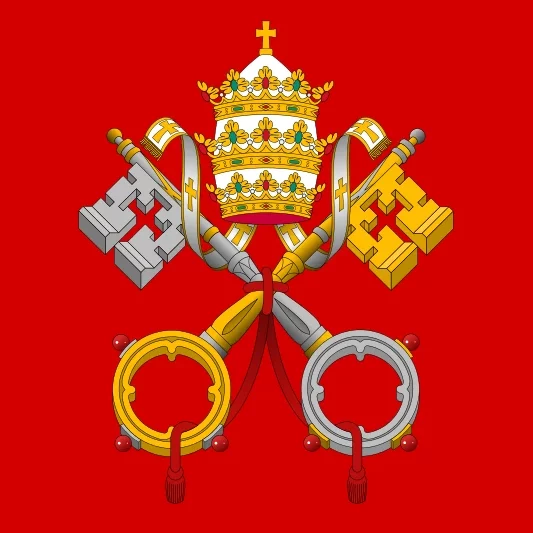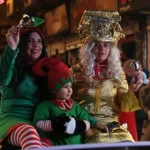Above: Soviet Army in Kiev, 1920
Part I: What is the Russian Catholic Church? Introduction
Part II: Heralds of a Catholic Russia
Part III: Venerable and Blessed Founders of the Russian Catholic Exarchate
The revolution struck hard.
In 1918, the number of Catholic parishioners in St. Petersburg alone was 400 lay people with a few thousand faithful Byzantine rite Catholics living across the country. Just three years later in 1921, this number was only about 10 priests and 380 lay people. About 2,000 faithful had died of starvation or fled abroad hiding from the Communists. There were still parishes in Moscow and St. Petersburg, small communities in other cities, some women’s monastic communities, educational circles and ecclesiastical associations. Even amidst that madness of Atheistic terror, Russian Catholics participated in charity, realising their Christian duty to attend those in need. In the difficult times of the early 1920s, the parish in Moscow was actively engaged in helping the poorest: feeding the hungry, caring for the sick; even an orphanage was opened by that relatively small community.
On December 5, 1922, the Bolshevik persecution intensified, which led to all Catholic Churches of all rites being closed. The majority of Russian Catholic priests, religious and laity had been arrested and convicted in mass cases against ‘counter-revolutionary Catholic clergy.’ Many of them had to endure exile, torture, and went through the gulag. In 1937, many of those who lived were killed by the NKVD.
In February 1923 Exarch Leonid Fedorov himself was arrested. He appointed Fr. Nikolai Alexandrov as his deputy in Moscow. The latter served in the Abrikosov community, but could barely cope with the entire load.
Fr. Nikolai Alexandrov
In 1926, Russian Catholics of the Byzantine rite temporarily submitted to the apostolic administrator of Moscow, Bishop Pie Eugène Neveu – a man of holy life and apostolic zeal for mission.
Father Sergiy Solovyov (1885-1942), Vice-Exarch of Russian Catholics
In 1926, after Exarch Leonid Fedorov was arrested, Bishop Pie Neveu appointed Fr. Sergiy Solovyov – Vladimir Solovyov the Philosopher’s own nephew – as vice-exarch for Catholics of the Byzantine rite in Russia. His unofficial Eastern Liturgies would take place at the side altar of the Roman Catholic Cathedral of the Immaculate Conception in Moscow.
Fr. Sergiy Solovyov
On February 16, 1931, Fr. Sergiy was arrested as well. After a long investigation and various tortures, he was sent for compulsory treatment to a psychiatric hospital in Kazan, where he eventually died in 1941.
Varflomey Remov (1888-1935), an Orthodox Archbishop who became Catholic
It was 1932 when Archbishop Varflomey Remov, the closest assistant to Metropolitan Sergiy Stragorodsky, secretly joined the Catholic Church.
Archbishop Varflomey Remov
In 1933, Pope Pius XI established the titular Diocese of Sergiev under the direct jurisdiction of Rome for Archbishop Varflomey to head as vicar for Byzantine Rite Catholics. He would meet with various Russian Orthodox hierarchs like Metropolitan Arseniy (Stadnitsky), Metropolitan Anatoly (Grisyuk) and others at his apartment where the issue of union with Rome was discussed as a means to overcome internal turmoil the Russian Church was going through.
The Archbishop headed an underground Vysoko-Petrovsky Monastery in Moscow, which was sheltered at the Nativity of the Holy Virgin Mary Church in Putinki. At this monastery, a secret monastic community of Byzantine rite Catholics began.
In February 1935, Archbishop Varflomey Remov and his closest spiritual children were arrested and shot soon after by the Soviets.
On March 7, 1935, after long suffering and illness endured in the Solovetsky camp and various prisons, Blessed Leonid Fedorov died in the city of Vyatka.
Blessed Klimenty Sheptytsky (1869-1951), Uniate Archimandrite and Second Russian Exarch
In 1935, Metropolitan Andrey Sheptytsky appointed his younger brother, Archimandrite of the Studite Monastery in Univ – Klimenty Sheptytsky – Exarch of ‘Great Russia and Siberia.’
Blessed Klimenty Sheptytsky
In 1939, using his powers received from Pope St. Pius X, Metropolitan Andrey divided all of Soviet Russia into several canonical entities subordinated directly to Rome. In 1940 the Holy See confirmed the decision. Unfortunately, Klimenty could not control much of the pastoral territory he had to oversee, especially because he lived in Lvov. In 1947, when the Soviets came to Western Ukraine, Klimenty Sheptytsky was taken under arrest and sentenced to ten years in prison.
Having to survive under conditions of torture and constant interrogation, Blessed Klimenty would reassure and encourage his spiritual children, praying constantly and even calling his own prison cell a monastic one, which earned him the recognition of sanctity even from his Orthodox fellow prisoners.
On May 1, 1951, Blessed Archimandrite and Exarch Clement died in the Vladimir prison on the Klyazma.
In 1991, Archimandrite Klimenty Sheptytsky was posthumously rehabilitated by the Prosecutor’s Office of the Ukrainian Soviet Socialist Republic. He was beatified by Pope St. John Paul II in 2001 in Lvov during the official visit of the Holy Father to Ukraine. In 1996 Blessed Clementy received the title of ‘Righteous Among the Nations’ for saving Jews during the Holocaust. It is also known that the chief rabbi of Lvov, being in exile, named his son Clement in honour of that Uniate priest who saved his life.[1]
Sheptytsky tomb
In Exile…
Solemn Liturgy in the Cathedral of St. Peter in Rome. The head celebrant – Bishop Alexander Evreinov. Archimandrite Klimenty Sheptytsky is among the co-celebrants in the photo.
The life and works of Russian Catholics continued among the Russian emigrants, who preserved the traditional forms of the Russian ‘synodal’ rite native to them, enriching their faith by maintaining full communion with the Apostolic See.
For three years between 1930 – 1933 the Apostolic Visitor for Russian Catholics in Central and Western Europe was Archbishop Peter Buchys (1872-1951). Hieromonk Alexander Evreinov (1877-1959) was also an important figure in the Russian Catholic diaspora. Staying in France, he continued the work that started in Russia during the time of Blessed Fr. Leonid Fedorov. Thus he opened a parish in honour of the Holy Trinity, founded ‘The Blagovest’ magazine; it was on his initiative that The Brotherhood of Prayer for Church Unity arose in the immigrant circles. On December 6, 1936, Evreinov was elevated to the rank of bishop. It was then Bishop Alexander who on May 25, 1938, for the first time in the history of St. Peter’s Basilica in Rome, celebrated the solemn Liturgy of St. John Chrysostom according to the Russian rite on the occasion of the 950th anniversary of the Baptism of Rus.
Evreinov ordained many decent men for the Russian apostolate, one of whom was future Bishop Andrey Katkov. The next Apostolic Visitor for Russian Catholics of the Byzantine rite in emigration was Archbishop Boleslav Sloskan (1893-1981), who, after many years spent in Soviet camps and prisons, including notorious Solovki, where he stayed with Leonid Fedorov, fled the country in 1933.
Bishop Andrey Katkov (1916-1995), plenipotentiary visitor for Russian Catholics of the Byzantine rite living abroad
The last Apostolic Visitor for Russian Catholics of the Byzantine Rite was Bishop Andrey Katkov, appointed to this position by Pope St. John XXIII in 1960.
Bishop Andrey Katkov
In the same year, His Grace was elected a member of the Congregation for the Eastern Churches, the next year also a consecrating bishop for the Eastern Rite. Bishop Katkov was among the conciliar fathers of the Second Vatican Council, where he even celebrated a Liturgy according to the Russian rite in St. Peter’s Basilica in the presence of the Pope and the entire episcopate of the Council.
In August 1969, at the invitation of Metropolitan Nikodim (Rotov), Andrey Katkov visited the USSR, going to Moscow and other cities of Russia and Ukraine. During that visit to Russia, His Grace visited various Russian Orthodox parishes and monasteries, where he was greeted the way one should greet a bishop according to the Eastern tradition. Bishop Andrey died on September 18, 1995. He was buried in the crypt of the Hellenic College in the Roman cemetery of Campo Verano.
Andrey Katcov at the Working Session of Vatican II
Bishop Andrey Katkov Meeting Pope St. John XXIII
A Russian Rite Liturgy at the Second Vatican Council with Bishop Andrey Katkov
The Current State of Affairs
The modern history of the Russian Catholic Church of the Byzantine Rite begins in the first half of the 1990s in a couple of Russian cities including St. Petersburg and Moscow with small groups of Russian rite Catholics gathering together for common prayers and considering themselves the heirs of the tradition that Blessed Leonid Fedorov and his associates bequeathed to them almost a century ago.
On December 20, 2004, Pope John Paul II appointed Bishop Joseph Werth SJ, head of the Transfiguration Roman Catholic diocese in Novosibirsk, as the Ordinary with the rights of a diocesan bishop for Byzantine Catholics in Russia ‘in order to expand and more appropriately streamline pastoral care for them.’
In addition to Russian converts, a large number of Greek Catholics of Ukrainian origin have been living throughout Russia since the Soviet times. They are our brothers and sisters in one true Church, who, having their own history and in many regards being different from us, do not just share with their Russian peers the same ecclesiastical jurisdiction, but also revere the same Blessed Klimenty Sheptytsky and Leonid Fedorov – those blessed martyrs of the past that unite us spiritually.
There are also Russian parishes abroad, and in recent years there have been intensified attempts to establish a better connection between the Russian Catholic diaspora in America, Europe and Australia with the Church in Russia, as well as petitions sent to Rome asking for the caput et pater for our Russian Catholic Church sui iuris, so it can grow and fulfill its mission of saving souls and healing the schism between Christians, for which I invite you to pray with me!
[1] ‘Blessed Martyr Klimenty Sheptytsky’ in Восточный Католик online journal.











